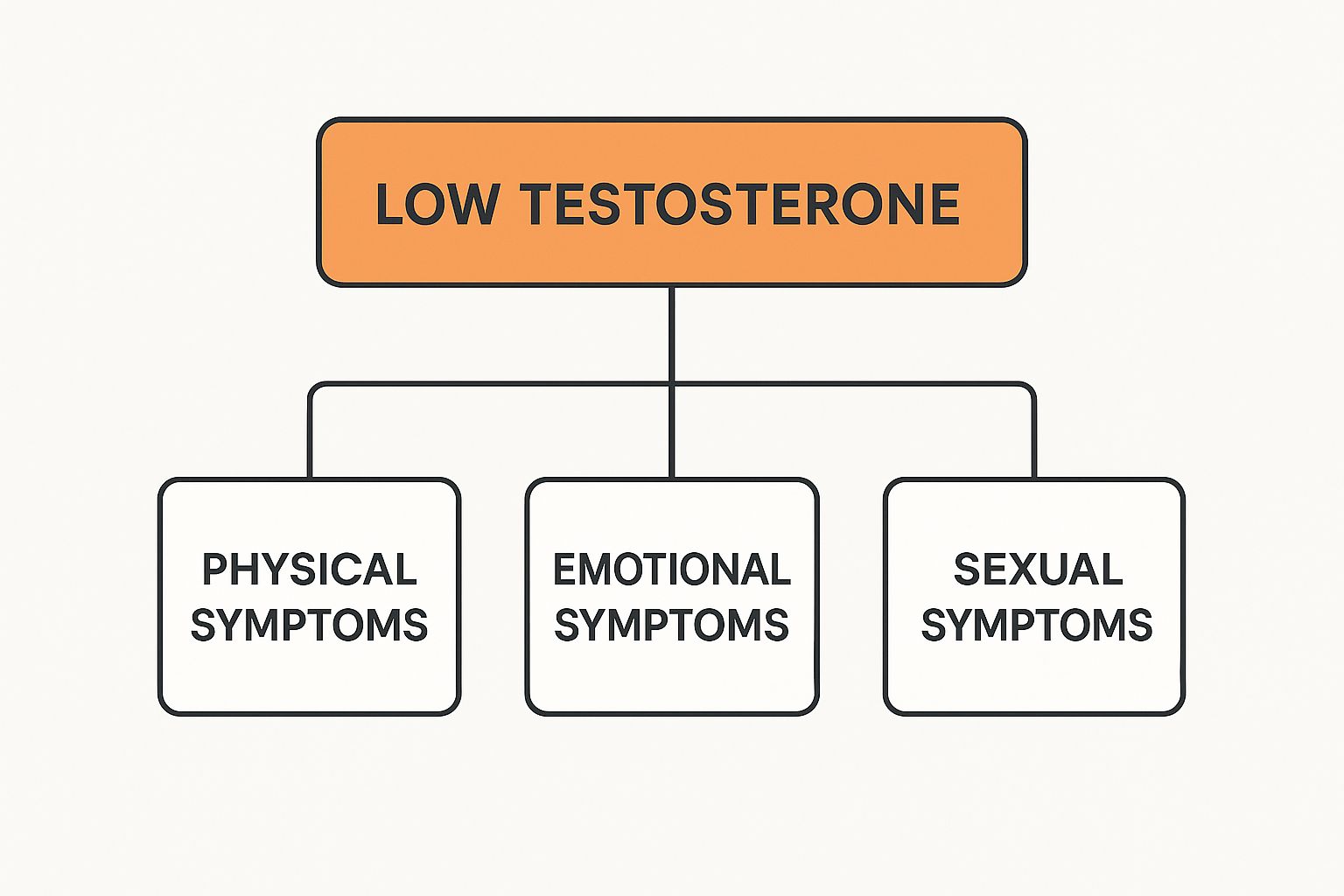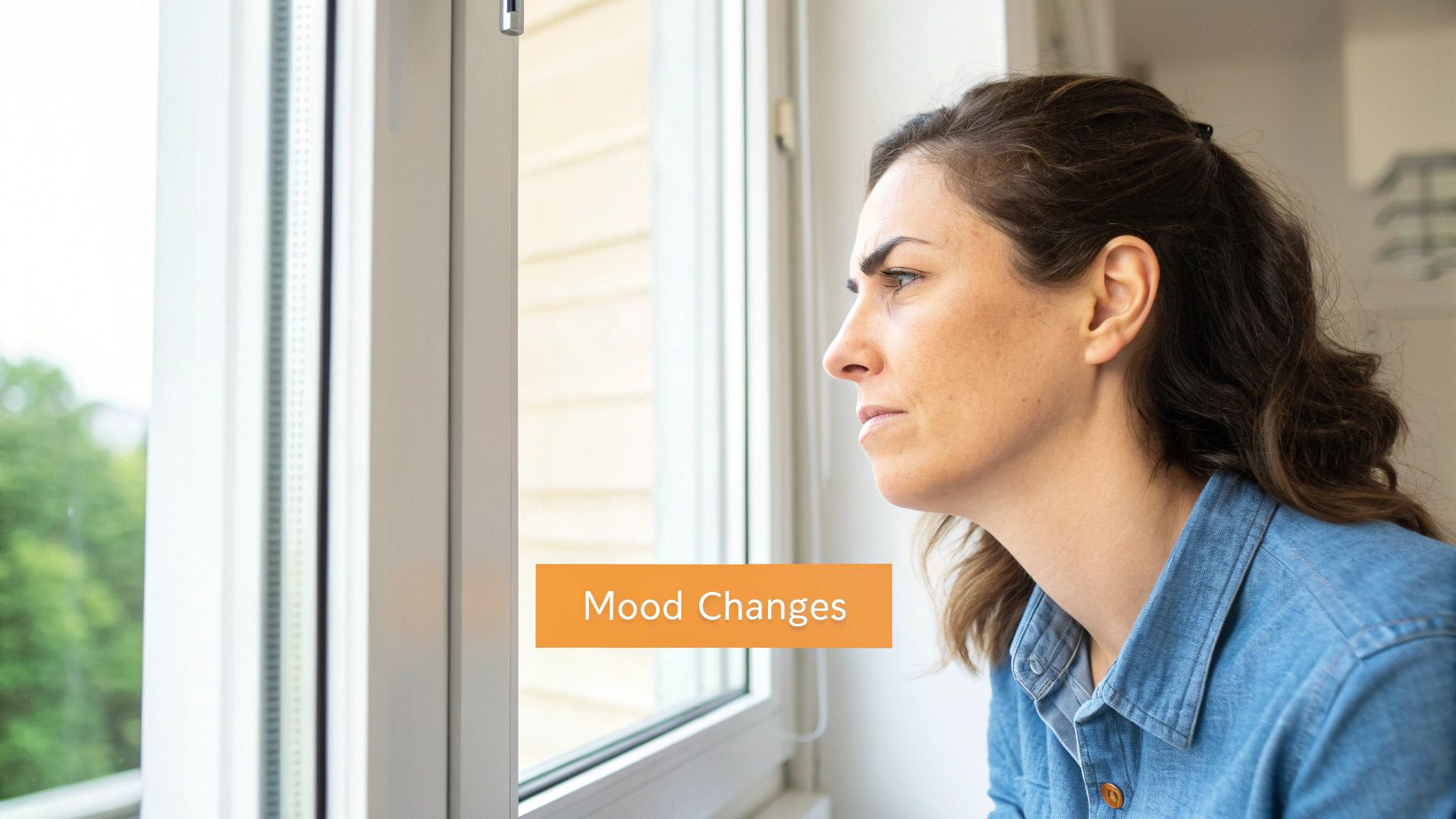Symptoms of Low Testosterone in Women: Essential Signs to Know

When you hear the term “low testosterone,” your mind probably jumps to men’s health. But it's a persistent myth that testosterone is exclusively a male hormone. The truth is, it's an absolutely crucial player in a woman's overall vitality.
Think of your hormonal system like a finely tuned orchestra. When every instrument is playing its part correctly, the result is beautiful harmony. Testosterone is one of those key instruments for women, and when its levels drop too low, the entire symphony can feel jarringly out of sync.
Understanding Testosterone's Role In Women's Health
Produced in the ovaries and adrenal glands, testosterone is essential for regulating a woman’s energy, mood, muscle strength, and even mental sharpness. When levels are where they should be, this powerful hormone helps support:
- Strong Bones and Muscles: It’s vital for maintaining bone density and lean muscle mass.
- Healthy Libido: Testosterone is a primary driver of sexual desire and satisfaction.
- Stable Mood: It plays a role in regulating the neurotransmitters that influence your mood and motivation.
The problem is, this crucial hormone often gets overlooked. By the time a woman reaches age 40, her testosterone levels can plummet by half from their peak. This drop can trigger a cascade of symptoms, from a noticeable dip in libido and persistent fatigue to muscle weakness and brain fog.
This infographic breaks down some of the most common signs into three main categories, showing just how widespread the effects can be.

As the visual shows, a single hormonal imbalance can ripple outward, creating physical, emotional, and sexual challenges that are easy to misattribute to stress or aging.
To give you a clearer idea of what to look for, this table organizes the symptoms into categories you might recognize in your daily life.
At-a-Glance Guide to Low Testosterone Symptoms
| Symptom Category | Common Signs You Might Notice |
|---|---|
| Physical | Persistent fatigue, decreased muscle mass, weight gain (especially around the abdomen), thinning hair, dry skin, and reduced libido. |
| Emotional | Unexplained mood swings, increased irritability, feelings of apathy or depression, and a general lack of motivation. |
| Cognitive | Difficulty concentrating ("brain fog"), memory lapses, and a noticeable decline in mental sharpness or focus. |
This guide is designed to help you connect the dots between how you're feeling and what might be happening inside your body.
Testosterone isn't just about sex drive; it's a foundational hormone that supports a woman's energy, resilience, and mental sharpness. Recognizing its importance is the first step toward addressing a deficiency.
This balance is incredibly delicate and deeply interconnected with other hormones like estrogen and progesterone. Achieving proper hormonal balance for women is the key to feeling your best, because when one hormone is out of whack, it often pulls the others down with it. As we dig deeper, think of each symptom as a clue. This guide will help you put those clues together, giving you a clear picture of what to look for and how to start a productive conversation about your health.
While the mental and emotional fallout is a huge piece of the puzzle, the physical signs of low testosterone in women are often the most concrete and frustrating. These aren't just vague feelings of being "off." We're talking about real, measurable changes in your body that can disrupt your daily life, from your energy levels to what you see in the mirror.

Think of testosterone as the foreman on your body's construction site. It's the one directing the crew that builds and maintains strong muscles and bones. When that foreman doesn't show up for work, projects grind to a halt, and the whole structure starts to weaken.
Persistent Fatigue and Muscle Weakness
One of the most common complaints I hear is a deep, bone-weary fatigue that no amount of sleep seems to touch. This isn't your typical "I had a long day" tiredness. It's a profound lack of energy that can make even simple tasks feel like climbing a mountain.
This exhaustion often goes hand-in-hand with a noticeable drop in physical strength. You might find that your usual workout feels impossible all of a sudden, or that you're struggling to lift things that were never a problem before. That’s because testosterone is a key player in muscle protein synthesis.
Without enough of it, your body can't effectively repair and build lean muscle tissue. This leads to a cascade of issues:
- Decreased Stamina: You might get winded much faster during any kind of physical activity.
- Slower Recovery: It can take ages to bounce back from a workout or even just a busy day.
- Loss of Strength: You'll notice a gradual but frustrating decline in what you're physically capable of doing.
This isn't just about how you perform at the gym. Maintaining muscle is absolutely crucial for a healthy metabolism and your overall sense of vitality.
Changes in Body Composition
Another telltale sign is a frustrating shift in how your body looks and feels, particularly where it stores fat. Testosterone helps preserve lean muscle mass—and muscle burns more calories, even when you're resting. When testosterone dips, your metabolism can slow right down with it.
As a result, many women notice more body fat creeping on, especially that stubborn fat around the abdomen. This can happen even when you haven't changed a single thing about your diet or exercise routine. It feels like you're fighting an uphill battle you just can't win.
Low testosterone can tilt your body's delicate balance, favoring fat storage over muscle maintenance. This shift is a direct physiological response to the hormonal change, not a reflection of your effort or willpower.
The prevalence of these symptoms varies a lot, especially with age. Post-menopausal women, for example, are often more affected. In the United States, an estimated 10 to 15 million women may have an androgen deficiency, which is a major contributor to these physical changes. You can read more about the facts surrounding testosterone insufficiency in women to get a better sense of the issue's scope.
Skin, Hair, and Bone Health
The physical signs don't stop at muscle and fat. Testosterone also plays a supporting role in maintaining the integrity of your skin, hair, and even bones. Some women might start to experience:
- Dry, Thinning Skin: A loss of collagen and elasticity can leave your skin feeling less supple and resilient.
- Hair Loss: You might notice more shedding in the shower or that your hair just seems thinner all over.
It's easy to write these more subtle symptoms off as just a normal part of getting older. But they can be important clues, pointing toward a hormonal imbalance that's worth investigating.
How Hormone Imbalance Affects Mood and Mental Clarity
While physical symptoms are often easier to spot, the toll low testosterone takes on your mind and emotions can be just as disruptive. If you've been battling "brain fog," feeling a wave of anxiety out of nowhere, or wondering where all your motivation went, your hormones could be the real culprit.
These aren't just feelings you have to push through; they're physiological responses to a crucial hormonal shortfall.

Think of your brain chemistry as a finely tuned orchestra. Testosterone is a key conductor, helping to direct neurotransmitters like dopamine—the chemical messenger of motivation, pleasure, and focus. When testosterone levels drop, it's like the conductor has walked off stage, leaving the orchestra to create a chaotic, jumbled sound.
This internal dissonance shows up in several frustrating ways, making you feel completely unlike yourself.
The Frustration of Brain Fog and Poor Concentration
One of the most common complaints is a persistent mental cloudiness often called brain fog. It’s so much more than just being a little forgetful; it feels like a tangible barrier that gets in the way of clear thinking.
This frustrating experience can break down into specific daily struggles:
- Memory Lapses: You might walk into a room and completely forget why you're there. Or maybe you struggle to recall names and details that used to be second nature.
- Difficulty Concentrating: Trying to focus on a single task—whether it's reading a report for work or just following a conversation—can feel like a monumental effort.
- Reduced Mental Sharpness: Complex problem-solving or multitasking can suddenly feel overwhelming, leaving you feeling slow and inefficient.
This isn't a personal failing. Low testosterone directly impacts the parts of your brain in charge of executive function, memory, and attention. The mental fatigue you feel is a very real symptom of this hormonal imbalance.
Mood Swings, Irritability, and Apathy
Beyond just focus, testosterone plays a vital role in keeping your emotions stable. Its decline can leave you feeling emotionally raw and unpredictable, reacting in ways that might even surprise you. Many women report a noticeable increase in irritability or a much shorter fuse over minor issues.
Low testosterone doesn't just drain your physical energy; it can sap your emotional resilience, making it harder to manage stress and maintain a stable mood. Your feelings are directly linked to your hormonal health.
This emotional instability can also lead to a flat, apathetic state. Activities you once loved might suddenly lose their appeal, and you may struggle to muster any enthusiasm for social events or personal hobbies. This isn't necessarily depression in the classic sense, but rather a blunted emotional response that’s directly tied to the hormonal shifts happening inside your body.
Recognizing these mental and emotional symptoms of low testosterone in women is crucial for seeing the complete picture of your health.
The Connection to Libido and Sexual Wellness
When women start researching low testosterone, the conversation almost always kicks off with libido. While a dwindling sex drive is a massive part of the story, it’s really just the tip of the iceberg. Testosterone is one of the primary hormones driving female libido, directly firing up sexual desire, arousal, and even how intense an orgasm feels.
Think of testosterone as the spark plug for your sexual engine. When your levels are optimal, desire feels natural and arousal happens easily. But when those levels are low, it can feel like you’re trying to start a car with a dead battery. The interest just… isn’t there. This can be incredibly confusing and distressing, especially when it has absolutely nothing to do with how you feel about your partner.
More Than Just a Lack of Desire
The ripple effects of low testosterone on sexual wellness go way beyond a simple lack of interest. The hormone is also critical for the physical side of intimacy, playing a huge role in tissue health and nerve sensitivity. This is where the symptoms shift from a mental hurdle to a tangible, physical barrier standing in the way of a satisfying sex life.
Without enough testosterone, many women notice physical changes that make sex uncomfortable or even painful. These often include:
- Reduced Sensitivity: Nerve endings in the clitoris and vaginal tissues can become less responsive. This makes it much harder to get aroused or reach orgasm.
- Vaginal Dryness: Testosterone helps keep vaginal tissues lubricated and elastic. When it’s in short supply, it can lead to dryness and thinning, causing friction and discomfort during intercourse.
- Diminished Orgasmic Intensity: For some women, orgasms might feel less powerful, or they might become difficult to achieve at all.
These physical symptoms can lock you into a frustrating cycle. The lack of desire is made worse by physical discomfort, which then kills any lingering interest in intimacy. It’s so important to see these as connected medical symptoms, not as a collection of unrelated problems.
A vanishing libido is often the first red flag, but physical changes like reduced sensitivity or vaginal dryness are just as critical. They confirm that what you're feeling is a physiological issue—not a personal or relational failure.
Reframing the Conversation
It's time we reframe this incredibly sensitive topic for what it is: a treatable medical condition. For far too long, a drop in female libido has been written off as an unavoidable part of getting older, a side effect of stress, or a sign of relationship trouble. And while those things can certainly play a role, a hormonal imbalance is a frequent—and frequently overlooked—culprit.
Understanding the direct line between testosterone and your sexual health is empowering. It shifts the story from one of self-blame to one of proactive health management. Recognizing these signs as potential symptoms of low testosterone in women is the first step toward having an informed conversation with a healthcare provider and finding solutions that can help you reclaim this vital part of your life.
How to Get an Accurate Diagnosis
Feeling dismissed by your doctor when you know something is off is one of the most frustrating experiences you can have. Getting to the bottom of low testosterone starts with a simple but critical understanding: an accurate diagnosis isn’t about a single number on a lab report. It’s about looking at the whole picture—your symptoms, your health history, and the right blood tests.
Think of your symptoms as the most important clues in a detective story. Your fatigue, mood shifts, and lack of libido are all pieces of the puzzle. The lab work is the forensic evidence that helps confirm the story your body is telling. The conversation you have with your doctor is just as crucial as the blood test itself.
The Nuances of Hormone Testing
When your doctor orders a blood test for testosterone, they’re usually looking at two key markers. Knowing the difference is a game-changer when it comes to advocating for yourself.
- Total Testosterone: This number measures every last bit of testosterone in your bloodstream. The catch? Most of it is bound to proteins, which means it’s not actually available for your cells to use.
- Free Testosterone: This measures the small, "unbound" portion of testosterone—only about 1-4% of the total—that is biologically active. This is the hormone that’s actually free to do its job and impact how you feel.
A good provider will also check other hormones like estrogen, progesterone, and your thyroid levels to make sure nothing else is causing your symptoms. If you want to get a head start, learning about how to check hormone levels at home can give you a baseline understanding before you even step into the clinic.
A "normal" lab result doesn't always mean "optimal." Standard lab ranges are often incredibly broad and may not reflect the level at which your body functions best. A real diagnosis puts your unique symptoms first and uses the lab values as context.
Preparing for a Productive Doctor's Visit
To get the most out of your appointment, you need to walk in prepared. When you’re organized and clear about what you’ve been going through, it helps your doctor connect the dots and take your concerns seriously. The goal is to turn a potentially frustrating conversation into a productive partnership.
To help you get organized and present a clear picture of your health, we've created a simple checklist. Think of this as your game plan for a successful consultation.
Your Checklist for a Productive Doctor's Visit
| Preparation Step | Details and Examples |
|---|---|
| Track Your Symptoms | Keep a simple journal for a few weeks. Note your energy on a scale of 1-10, mood changes, libido, and any physical shifts. Be specific: "Felt too exhausted for my usual workout 4 out of 7 days this week." |
| List Your Questions | Write down everything you want to ask so you don't forget. Examples: "Could my symptoms be related to low testosterone?" or "Should we be testing both my free and total testosterone levels?" |
| Gather Your History | Be ready to discuss your full medical history, list any medications or supplements you're taking, and mention major life events (like menopause or a period of high stress) that line up with when your symptoms started. |
Walking in with this information makes you a confident advocate for your own health. It shifts the conversation from "I just feel tired" to "Here is the specific data showing what's happening in my body, and I need your help to figure it out."
Exploring Your Treatment and Lifestyle Options
Getting a diagnosis for low testosterone is the first real step toward getting your vitality back. The path forward isn't just about one thing; it’s a smart combination of medical guidance and powerful lifestyle shifts that work together to restore your hormonal balance and help you feel like yourself again.
One of the main medical options is Testosterone Replacement Therapy (TRT). This isn't a one-size-fits-all prescription. For women, it demands careful, personalized dosing to get it just right. TRT comes in a few different forms, each with its own way of delivering the hormone.
- Topical Creams: You apply these to the skin, allowing for a slow, steady absorption of testosterone throughout the day.
- Pellets: These are tiny pellets inserted just under the skin. They release a consistent, low dose of the hormone over several months.
- Injections: While they deliver a very reliable dose, injections might mean regular visits to the clinic or learning to do them yourself at home.
No matter the method, expert monitoring is non-negotiable. This ensures your levels stay in a safe, optimal range and keeps any potential side effects to a minimum.
A Holistic Approach to Hormone Health
Beyond any medical treatment, your daily habits play a massive role in supporting your body's own hormone production. Think of it as building a strong foundation for your health—these strategies can seriously boost the effectiveness of any treatment plan you're on.
Here are the key areas to lock in on:
- Targeted Strength Training: Lifting weights sends a powerful signal to your body to produce more testosterone.
- Strategic Nutrition: Getting enough zinc, vitamin D, and healthy fats is absolutely crucial for creating hormones.
- Effective Stress Management: Chronic stress pumps out cortisol, a hormone that directly suppresses testosterone production.
Your lifestyle choices aren't just a nice add-on; they are fundamental to managing low testosterone in women. Combining medical treatment with these supportive habits creates the most resilient path back to wellness.
The stakes are high because low testosterone can affect much more than just your quality of life. Research has even pointed to a link between testosterone deficiency and increased mortality in certain health conditions. Historically, how testosterone therapy is prescribed for women has shifted, peaking at 19 per 10,000 women before dropping to 4 per 10,000 by 2017, which shows just how much our understanding of its importance is evolving. You can learn more about these findings on female testosterone deficiency.
If you're looking to build that strong foundation, check out our guide on how to increase testosterone levels naturally for some practical, actionable tips.
Your Questions Answered
When you start digging into hormonal health, a lot of questions pop up. It’s totally normal. Here, we'll tackle some of the most common ones we hear about low testosterone in women, with straight-to-the-point answers.
Can Low Testosterone Cause Weight Gain in Women?
Yes, it’s often a major player. Testosterone is absolutely vital for building and holding onto lean muscle mass, and muscle is your body’s metabolic engine.
When those testosterone levels drop, you can start losing that precious muscle and gaining fat, especially around your belly. This shift throws the brakes on your metabolism, making it incredibly frustrating to manage your weight, even if you haven't changed a thing about your diet or workout routine.
What Is a Normal Testosterone Level for a Woman?
This is where it gets tricky—there’s no single magic number that’s “normal” for every woman. Lab ranges for total testosterone typically fall somewhere between 15 and 70 ng/dL, but these numbers can shift based on your age and even the lab doing the test.
The most important thing to remember is that a good diagnosis is always about your symptoms first. A number that looks "low-normal" on a lab report could still be way too low for your unique body to feel and function its best.
Are There Natural Ways to Increase Testosterone?
Absolutely. Your daily habits can make a real difference in supporting healthy hormone balance. A few of the most powerful strategies include:
- Consistent Strength Training: Lifting weights sends a strong signal to your body to produce more testosterone. It's one of the best things you can do.
- Smart Nutrition: Make sure you’re getting enough key nutrients like zinc, vitamin D, and healthy fats from your diet.
- Managing Stress and Sleep: Nothing crushes hormone production faster than chronic stress and poor sleep. Prioritizing rest is non-negotiable.
While these habits are fantastic for your overall health, they sometimes aren’t enough to fix a significant, clinically low level on their own.
At Elite Bioscience, we’re here to give you a clear path toward understanding and taking control of your hormonal health. Take a look at our personalized therapies, all designed to help you get your energy and vitality back. Learn more about our solutions at elitebioscience.co.
QUICK SEARCH
Make an account today to start your journey towards a better and healthier lifestyle.






